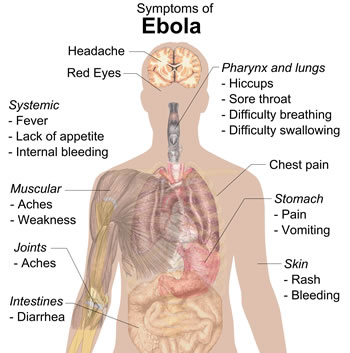Difference between Ebola and Flu
Key difference: Ebola is a rare and deadly disease that kills 25% to 90% of the people it infects. The flu spreads around the world in seasonal epidemics and is more common than Ebola affecting millions annually.

With the 2014 outbreak of Ebola, many people are scared to coming in contact with and being infected with Ebola. However, the chance of someone developing Ebola, especially someone not in a country with widespread Ebola outbreak, is very rare. Instead, it is more likely that a person would contract the flu. This is mainly because of the manner in which the two diseases spread.
The flu spreads easily, which is why there are flu epidemics nearly every year. The flu can spread through the droplets made when people who have flu cough, sneeze, or talk. They can also be spread through contamination of surfaces such as counters, doorknobs, etc. However this method is less common. Ebola, on the other is very hard to spread. One can only contract Ebola by coming in to direct contact with the bodily fluids, such as blood, saliva, mucus, vomit, feces, sweat, tears, breast milk, urine and semen of an infected person. The virus must enter the non-infected person’s body through the nose, mouth, eyes, open wounds, cuts and abrasions.
Additionally, in order to spread the virus, the infected person must already be showing symptoms, which may develop anywhere between 2 and 21 days. However, if even after 21 days the person does not show any symptoms, then it is not likely that it is Ebola. In the case of the flu, a person can spread the disease even before, during and even after they are sick. If infected with the flu, the symptoms may manifest suddenly and all at once within 2 days of exposure.
A way to tell the diseases apart is their symptoms. While the symptoms of Ebola might look similar to the flu’s symptoms, they are actually very different at second glance. Flu’s symptoms include fever, chills, shivering, cough, nasal congestion, runny nose, sneezing, body aches, fatigue, headache, petechial rash, irritated and watering eyes, as well as reddened eyes, skin, mouth, throat and nose. Some children may also experience diarrhea and abdominal pain.

Whereas, Ebola’s symptoms include fever, sore throat, muscle pain, and headaches. This then escalates to vomiting, diarrhea and a rash, as well as impaired kidney and liver function. In some cases, patients show both internal and external bleeding, such as oozing from the gums, or blood in the stools. This may eventually culminate to death between six to sixteen days of showing symptoms.
Ebola is a rare and deadly disease that kills 25% to 90% of the people it infects. Up to 2013, Ebola had a total of 1,716 reported cases in 24 outbreaks. In the 2014 West Africa Outbreak, Ebola has 13,042 reported cases that resulted in 4,818 deaths by 2nd November, 2014. While, the flu spreads around the world in seasonal epidemics, however it is not a simple disease. It causes five million yearly cases of severe illness and about 250,000 to 500,000 yearly deaths. In case of pandemics, the number of death may even increase to millions.
Comparison between Ebola and Flu:
|
|
Ebola |
Flu |
|
Known as |
Ebola virus disease (EVD), Ebola hemorrhagic fever (EHF) |
Influenza |
|
Caused by |
A virus of the family Filoviridae, genus Ebolavirus:
|
RNA viruses that make up three of the five genera of the family Orthomyxoviridae:
Influenzavirus A Influenzavirus B Influenzavirus C |
|
First Discovered |
In 1976 near the Ebola River in what is now the Democratic Republic of the Congo |
The symptoms of human influenza were clearly described by Hippocrates roughly 2,400 years ago. The word influenza was first used in English to refer to the disease we know today in 1703. |
|
Natural Hosts |
Fruit bats of the Pteropodidae family |
Influenzavirus A: Wild aquatic birds Influenzavirus B: almost exclusively infects humans Influenzavirus C: infects humans, dogs and pigs |
|
Transmission |
|
|
|
Incubation period (the time interval from infection with the virus to onset of symptoms) |
2 to 21 days |
Less than 2 days |
|
Symptoms |
Fever, fatigue, muscle pain, headache and sore throat. Followed by vomiting, diarrhoea, rash, symptoms of impaired kidney and liver function, and in some cases, both internal and external bleeding. |
|
|
Diagnosis |
Confirmation is made using the following investigations:
|
Confirmation is made by looking at the symptoms that the patient is exhibiting. If there is an outbreak in the area, then the prevalence of the flu is up to 70%. Rapid diagnostic tests are used in some instances to isolate viral culture. |
|
Treatment |
Rehydration with oral or intravenous fluids- and treatment of specific symptoms, improves rate of survival. |
Antiviral drugs such as neuraminidase inhibitors (oseltamivir and zanamivir) and M2 protein inhibitors (adamantane derivatives). People with the flu are advised to get plenty of rest, drink plenty of liquids, avoid using alcohol and tobacco and, if necessary, take medications such as acetaminophen (paracetamol) to relieve the fever and muscle aches associated with the flu. |
Image Courtesy: en.wikipedia.org









Add new comment